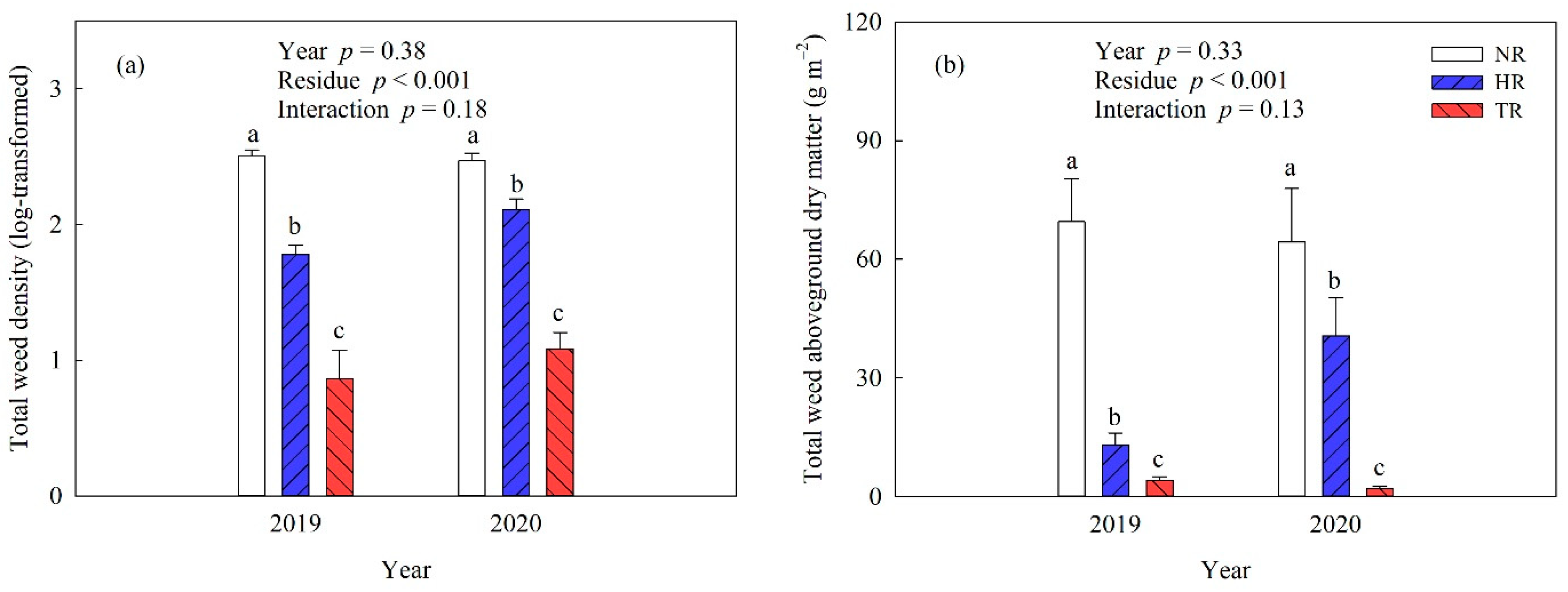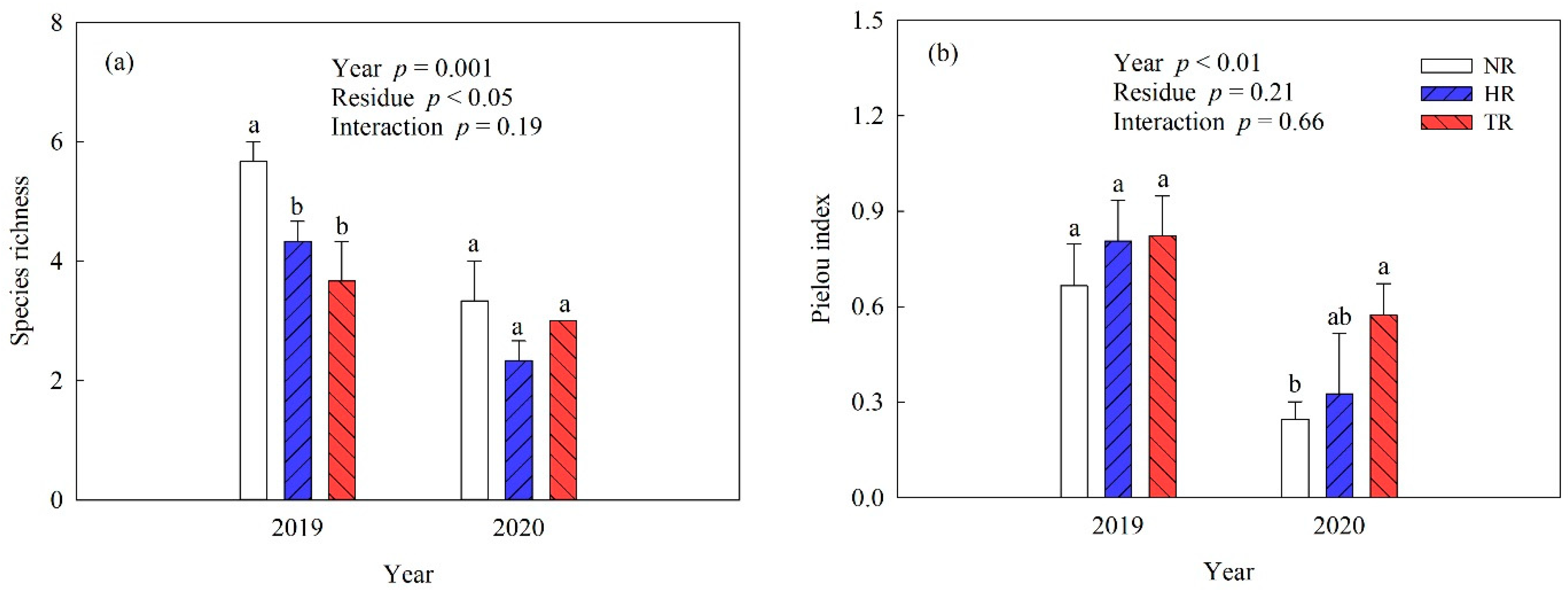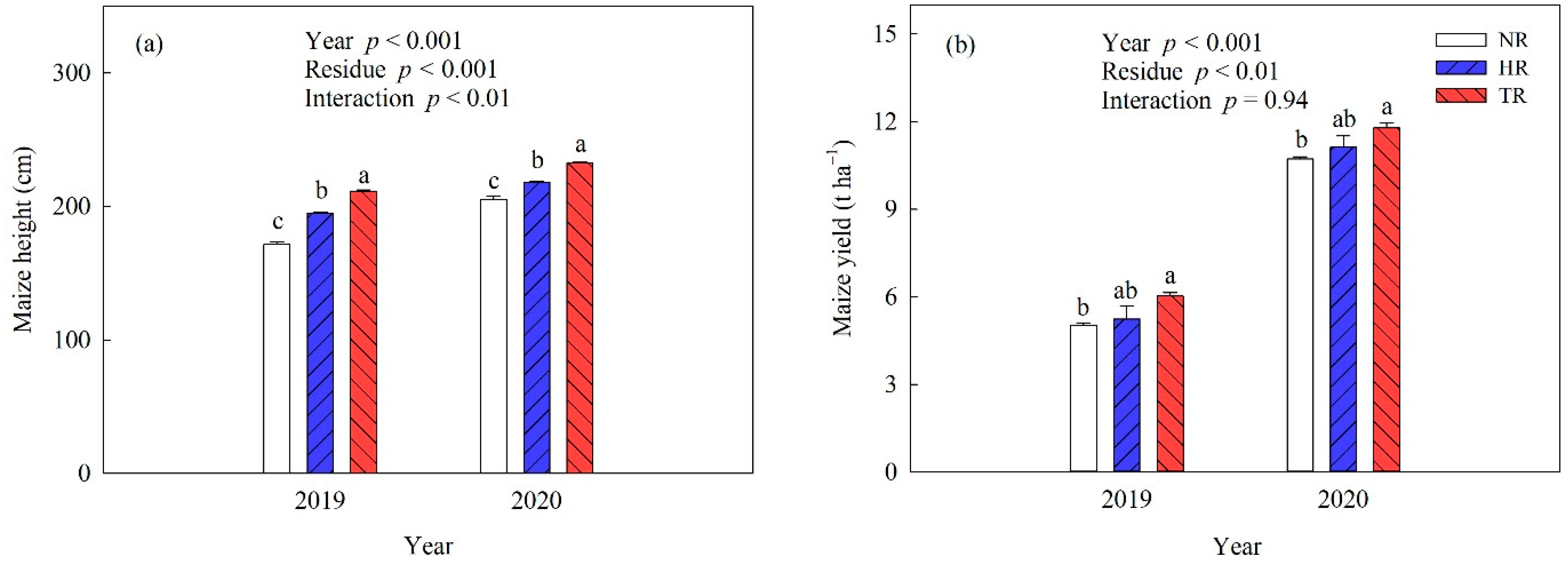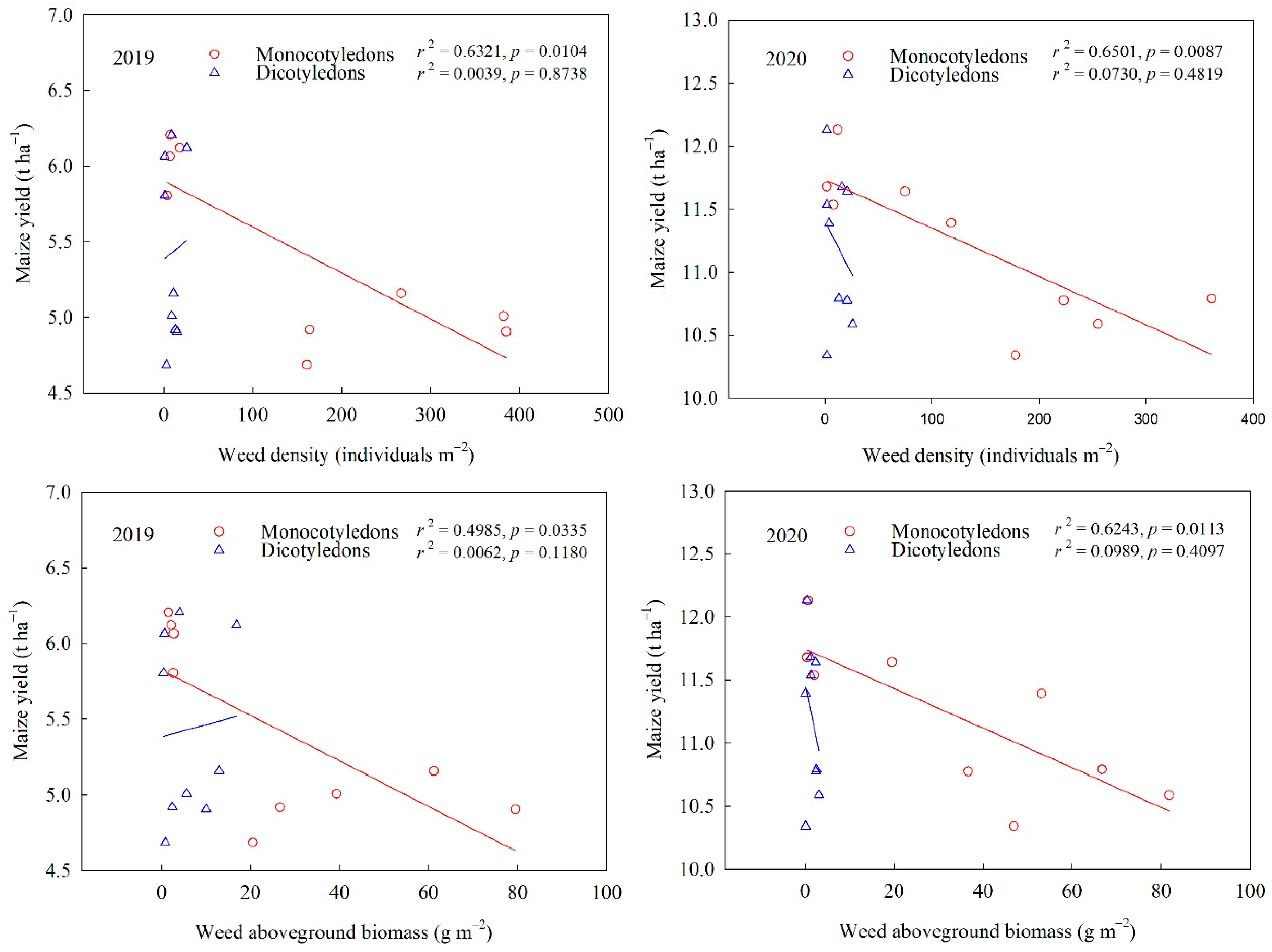Weed Responses to Crop Residues Management in a Summer Maize Cropland in the North China Plain
Abstract
:1. Introduction
2. Materials and Methods
2.1. Study Site
2.2. Experimental Design
2.3. Weed Community Evaluations
2.4. Statistical Analysis
3. Results
3.1. Density and Aboveground Dry Matter of Weeds
3.2. Weed Community Biodiversity
3.3. Impact of Weeds on Crop Growth and Yield
4. Discussion
4.1. Effects of Crop Residues Retention on Weed Density and Weed Aboveground Dry Matter
4.2. Effects of Crop Residues Retention on the Weed Community Diversity
4.3. Effects of Weeds on Maize Growth and Yield
5. Conclusions
Supplementary Materials
Author Contributions
Funding
Institutional Review Board Statement
Informed Consent Statement
Data Availability Statement
Acknowledgments
Conflicts of Interest
References
- San Martin, C.; Long, D.S.; Gourlie, J.A.; Barroso, J. Weed responses to fallow management in Pacific Northwest dryland cropping systems. PLoS ONE 2018, 13, e0204200. [Google Scholar] [CrossRef] [Green Version]
- Yang, M.; Zhao, Y.; Yang, H.; Shen, Y.; Zhang, X. Suppression of weeds and weed seeds in the soil by stubbles and no-tillage in an arid maize-winter wheat-common vetch rotation on the Loess Plateau of China. J. Arid. Land 2018, 10, 809–820. [Google Scholar] [CrossRef] [Green Version]
- Oerke, E.C. Crop losses to pests. J. Agric. Sci. 2005, 144, 31–43. [Google Scholar] [CrossRef]
- Annett, R.; Habibi, H.R.; Hontela, A. Impact of glyphosate and glyphosate-based herbicides on the freshwater environment. J. Appl. Toxicol. 2014, 34, 458–479. [Google Scholar] [CrossRef] [PubMed]
- Gaba, S.; Gabriel, E.; Chadoeuf, J.; Bonneu, F.; Bretagnolle, V. Herbicides do not ensure for higher wheat yield, but eliminate rare plant species. Sci. Rep. 2016, 6, 30112. [Google Scholar] [CrossRef]
- Murphy, C.E.; Lemerle, D. Continuous cropping systems and weed selection. Euphytica 2006, 148, 61–73. [Google Scholar] [CrossRef]
- Cardina, J.; Herms, C.P.; Doohan, D.J. Crop rotation and tillage system effects on weed seedbanks. Weed Sci. 2002, 50, 448–460. [Google Scholar] [CrossRef]
- Sarani, M.; Oveisi, M.; Mashhadi, H.R.; Alizade, H.; Gonzalez-Andujar, J.L. Interactions between the tillage system and crop rotation on the crop yield and weed populations under arid conditions. Weed Biol. Manag. 2014, 14, 198–208. [Google Scholar] [CrossRef] [Green Version]
- Murphy, S.D.; Clements, D.R.; Belaoussoff, S.; Kevan, P.G.; Swanton, C.J. Promotion of weed species diversity and reduction of weed seedbanks with conservation tillage and crop rotation. Weed Sci. 2006, 54, 69–77. [Google Scholar] [CrossRef]
- Dorado, J.; Lopez-Fando, C. The effect of tillage system and use of a paraplow on weed flora in a semiarid soil from central Spain. Weed Res. 2006, 46, 424–431. [Google Scholar] [CrossRef]
- Nandan, R.; Singh, V.; Singh, S.S.; Kumar, V.; Hazra, K.K.; Nath, C.P.; Poonia, S.P.; Malik, R.K. Comparative assessment of the relative proportion of weed morphology, diversity, and growth under new generation tillage and crop establishment techniques in rice-based cropping systems. Crop Protect. 2018, 111, 23–32. [Google Scholar] [CrossRef]
- Mohler, C.L.; Caldwell, B.A.; Marschner, C.A.; Cordeau, S.; Maqsood, Q.; Ryan, M.R.; DiTommaso, A. Weed seedbank and weed biomass dynamics in a long-term organic vegetable cropping systems experiment. Weed Sci. 2018, 66, 611–626. [Google Scholar] [CrossRef]
- Tang, L.; Wan, K.; Cheng, C.; Li, R.; Wang, D.; Pan, J.; Tao, Y.; Xie, J.; Chen, F. Effect of fertilization patterns on the assemblage of weed communities in an upland winter wheat field. J. Plant Ecol. 2013, 7, 39–50. [Google Scholar] [CrossRef] [Green Version]
- Alonso-Ayuso, M.; Gabriel, J.L.; García-González, I.; Del Monte, J.P.; Quemada, M. Weed density and diversity in a long-term cover crop experiment background. Crop Protect. 2018, 112, 103–111. [Google Scholar] [CrossRef]
- Reberg-Horton, S.C.; Grossman, J.M.; Kornecki, T.S.; Meijer, A.D.; Price, A.J.; Place, G.T.; Webster, T.M. Utilizing cover crop mulches to reduce tillage in organic systems in the southeastern USA. Renew. Agric. Food Syst. 2011, 27, 41–48. [Google Scholar] [CrossRef] [Green Version]
- Ngwira, A.R.; Aune, J.B.; Thierfelder, C. On-farm evaluation of the effects of the principles and components of conservation agriculture on maize yield and weed biomass in Malawi. Exp. Agric. 2014, 50, 591–610. [Google Scholar] [CrossRef] [Green Version]
- Koger, C.H.; Reddy, K.N. Effects of hairy vetch (Vicia villosa) cover crop and banded herbicides on weeds, grain yield, and economic returns in corn (Zea mays). J. Sustain. Agric. 2005, 26, 107–124. [Google Scholar] [CrossRef]
- Mohler, C.L.; Asdale, J.R. Response of weed emergence to rate of Vicia villosa Roth and Secale cereale L. residue. Weed Res. 1993, 33, 487–499. [Google Scholar] [CrossRef]
- Sun, H.; Zhang, X.; Chen, S.; Pei, D.; Liu, C. Effects of harvest and sowing time on the performance of the rotation of winter wheat–summer maize in the North China Plain. Ind. Crop. Prod. 2007, 25, 239–247. [Google Scholar] [CrossRef]
- Wu, L.-F.; Li, B.-b.; Qin, Y.; Gregorich, E. Soil CO2 emission and carbon budget of a wheat/maize annual double-cropped system in response to tillage and residue management in the North China Plain. Int. J. Agric. Sustain. 2017, 15, 253–263. [Google Scholar] [CrossRef]
- Mu, X.; Zhao, Y.; Liu, K.; Ji, B.; Guo, H.; Xue, Z.; Li, C. Responses of soil properties, root growth and crop yield to tillage and crop residue management in a wheat–maize cropping system on the North China Plain. Eur. J. Agron. 2016, 78, 32–43. [Google Scholar] [CrossRef]
- Zhang, X.; Pei, D.; Chen, S.; Sun, H.; Yang, Y. Performance of double-cropped winter wheat–summer maize under minimum irrigation in the North China Plain. Agron. J. 2006, 98, 1620–1626. [Google Scholar] [CrossRef]
- Dai, X.; Li, Y.; Ouyang, Z.; Wang, H.; Wilson, G.V. Organic manure as an alternative to crop residues for no-tillage wheat–maize systems in North China Plain. Field Crop. Res. 2013, 149, 141–148. [Google Scholar] [CrossRef]
- Zhang, J.; Wu, L.-F. Impact of tillage and crop residue management on the weed community and wheat yield in a wheat–maize double cropping system. Agriculture 2021, 11, 265. [Google Scholar] [CrossRef]
- Campiglia, E.; Radicetti, E.; Mancinelli, R. Weed control strategies and yield response in a pepper crop (Capsicum annuum L.) mulched with hairy vetch (Vicia villosa Roth.) and oat (Avena sativa L.) residues. Crop Protect. 2012, 33, 65–73. [Google Scholar] [CrossRef]
- Teasdale, J.R.; Mohler, C.L. Light transmittance, soil temperature, and soil moisture under residue of hairy vetch and rye. Agron. J. 1993, 85, 673–680. [Google Scholar] [CrossRef]
- Flower, K.C.; Ward, P.R.; Micin, S.F.; Cordingley, N. Crop rotation can be used to manipulate residue levels under no-tillage in a rainfed Mediterranean-type environment. Soil Tillage Res. 2021, 212, 105062. [Google Scholar] [CrossRef]
- Putnam, A.R.; Defrank, J. Use of phytotoxic plant residues for selective weed control. Crop Protect. 1983, 2, 173–181. [Google Scholar] [CrossRef]
- Mulhouse, J.M.; Hallett, L.M.; Collins, S.L.; Vandvik, V. The influence of seasonal precipitation and grass competition on 20 years of forb dynamics in northern Chihuahuan Desert grassland. J. Veg. Sci. 2017, 28, 250–259. [Google Scholar] [CrossRef]
- Tetetla-Rangel, E.; Dupuy, J.M.; Hernández-Stefanoni, J.L.; Hoekstra, P.H. Patterns and correlates of plant diversity differ between common and rare species in a neotropical dry forest. Biodivers. Conserv. 2017, 26, 1705–1721. [Google Scholar] [CrossRef]
- Jin, Y.; Li, J.; Liu, C.; Liu, Y.; Zhang, Y.; Song, Q.; Sha, L.; Chen, A.; Yang, D.; Li, P. Response of net primary productivity to precipitation exclusion in a savanna ecosystem. For. Ecol. Manag. 2018, 429, 69–76. [Google Scholar] [CrossRef]
- Collins, D.B.G.; Bras, R.L. Plant rooting strategies in water-limited ecosystems. Water Resour. Res. 2007, 43. [Google Scholar] [CrossRef]
- Govaerts, B.; Sayre, K.D.; Goudeseune, B.; De Corte, P.; Lichter, K.; Dendooven, L.; Deckers, J. Conservation agriculture as a sustainable option for the central Mexican highlands. Soil Tillage Res. 2009, 103, 222–230. [Google Scholar] [CrossRef]
- Cleland, E.E.; Collins, S.L.; Dickson, T.L.; Farrer, E.C.; Gross, K.L.; Gherardi, L.A.; Hallett, L.M.; Hobbs, R.J.; Hsu, J.S.; Turnbull, L.; et al. Sensitivity of grassland plant community composition to spatial vs. temporal variation in precipitation. Ecology 2013, 94, 1687–1696. [Google Scholar] [CrossRef] [Green Version]
- Pake, C.E.; Venable, D.L. Is coexistence of Sonoran desert annuals mediated by temporal variability in reproductive success. Ecology 1995, 76, 246–261. [Google Scholar] [CrossRef]
- Jin, Y.; Li, J.; Liu, C.; Liu, Y.; Zhang, Y.; Song, Q.; Sha, L.; Balasubramanian, D.; Chen, A.; Yang, D.; et al. Precipitation reduction alters herbaceous community structure and composition in a savanna. J. Veg. Sci. 2019, 30, 821–831. [Google Scholar] [CrossRef]
- Steponavičienė, V.; Marcinkevičienė, A.; Butkevičienė, L.M.; Skinulienė, L.; Bogužas, V. The effect of different soil tillage systems and crop residues on the composition of weed communities. Agronomy 2021, 11, 1276. [Google Scholar] [CrossRef]
- Turmel, M.-S.; Speratti, A.; Baudron, F.; Verhulst, N.; Govaerts, B. Crop residue management and soil health: A systems analysis. Agric. Syst. 2015, 134, 6–16. [Google Scholar] [CrossRef]
- Dikgwatlhe, S.B.; Chen, Z.-D.; Lal, R.; Zhang, H.-L.; Chen, F. Changes in soil organic carbon and nitrogen as affected by tillage and residue management under wheat–maize cropping system in the North China Plain. Soil Tillage Res. 2014, 144, 110–118. [Google Scholar] [CrossRef]
- Sarkar, S.; Skalicky, M.; Hossain, A.; Brestic, M.; Saha, S.; Garai, S.; Ray, K.; Brahmachari, K. Management of crop residues for improving input use efficiency and agricultural sustainability. Sustainability 2020, 12, 9808. [Google Scholar] [CrossRef]
- Campiglia, E.; Radicetti, E.; Mancinelli, R.; Albrecht, H. Floristic composition and species diversity of weed community after 10 years of different cropping systems and soil tillage in a Mediterranean environment. Weed Res. 2018, 58, 273–283. [Google Scholar] [CrossRef]
- Ghosh, D.; Brahmachari, K.; Skalicky, M.; Hossain, A.; Sarkar, S.; Dinda, N.K.; Das, A.; Pramanick, B.; Moulick, D.; Brestic, M.; et al. Nutrients supplementation through organic manures influence the growth of weeds and maize productivity. Molecules 2020, 25, 4924. [Google Scholar] [CrossRef] [PubMed]
- Ghosh, D.; Brahmachari, K.; Brestic, M.; Ondrisik, P.; Hossain, A.; Skalicky, M.; Sarkar, S.; Moulick, D.; Dinda, N.K.; Das, A.; et al. Integrated weed and nutrient management improve yield, nutrient uptake and economics of maize in the rice-maize cropping system of eastern India. Agronomy 2020, 10, 1906. [Google Scholar] [CrossRef]
- Summers, H.; Karsten, H.D.; Curran, W.; Malcolm, G.M. Integrated weed management with reduced herbicides in a no-till dairy rotation. Agron. J. 2021. [Google Scholar] [CrossRef]
- Pratibha, G.; Rao, K.V.; Srinivas, I.; Raju, B.M.K.; Shanker, A.K.; Madhavi, M.; Indoria, A.K.; Rao, M.S.; Murthy, K.; Reddy, K.S.; et al. Weed shift and community diversity in conservation and conventional agriculture systems in pigeonpea- castor systems under rainfed semi-arid tropics. Soil Tillage Res. 2021, 212, 105075. [Google Scholar]
- Hossain, M.M.; Begum, M.; Hashem, A.; Rahman, M.M.; Ahmed, S.; Hassan, M.M.; Javed, T.; Shabbir, R.; Hadifa, A.; Sabagh, A.E.L.; et al. Strip tillage and crop residue retention decrease the size but increase the diversity of the weed seed bank under intensive rice-based crop rotations in Bangladesh. Agronomy 2021, 11, 1164. [Google Scholar] [CrossRef]





| NR | HR | TR | |
|---|---|---|---|
| 2019 | |||
| Monocotyledon | 311.33 ± 35.71 a (96.39) | 47.67 ± 14.86 b (77.30) | 6.00 ± 1.00 c (62.07) |
| Dicotyledon | 11.67 ± 1.76 a (3.61) | 14.00 ± 6.66 a (22.70) | 3.67 ± 2.67 a (37.93) |
| Total weed | 323.00 ± 34.59 a | 61.67 ± 9.60 b | 9.67 ± 3.28 c |
| 2020 | |||
| Monocotyledon | 280.33 ± 42.35 a (93.34) | 123.67 ± 29.87 b (93.22) | 6.33 ± 2.96 c (48.69) |
| Dicotyledon | 20.00 ± 3.79 a (6.66) | 9.00 ± 6.03 a (6.78) | 6.67 ± 4.67 a (51.31) |
| Total weed | 300.33 ± 39.31 a | 132.67 ± 24.83 b | 13.00 ± 3.21 c |
| NR | HR | TR | |
|---|---|---|---|
| 2019 | |||
| Monocotyledon | 60.00 ± 11.62 a (86.33) | 6.40 ± 2.43 b (48.97) | 2.27 ± 0.38 c (55.37) |
| Dicotyledon | 9.50 ± 2.12 a (13.67) | 6.67 ± 5.09 a (51.03) | 1.83 ± 1.33 a (44.63) |
| Total weed | 69.50 ± 10.85 a | 13.07 ± 2.99 b | 4.10 ± 0.95 b |
| 2020 | |||
| Monocotyledon | 61.70 ± 13.29 a (95.85) | 39.83 ± 10.32 b (97.96) | 1.00 ± 0.50 c (50.76) |
| Dicotyledon | 2.67 ± 0.22 a (4.15) | 0.83 ± 0.73 ab (2.04) | 0.97 ± 0.28 b (49.24) |
| Total weed | 64.37 ± 13.47 a | 40.66 ± 9.60 b | 1.97 ± 0.69 b |
Publisher’s Note: MDPI stays neutral with regard to jurisdictional claims in published maps and institutional affiliations. |
© 2021 by the authors. Licensee MDPI, Basel, Switzerland. This article is an open access article distributed under the terms and conditions of the Creative Commons Attribution (CC BY) license (https://creativecommons.org/licenses/by/4.0/).
Share and Cite
Zhang, J.; Wu, L.-F.; Li, B.-B. Weed Responses to Crop Residues Management in a Summer Maize Cropland in the North China Plain. Agriculture 2021, 11, 746. https://doi.org/10.3390/agriculture11080746
Zhang J, Wu L-F, Li B-B. Weed Responses to Crop Residues Management in a Summer Maize Cropland in the North China Plain. Agriculture. 2021; 11(8):746. https://doi.org/10.3390/agriculture11080746
Chicago/Turabian StyleZhang, Jin, Lan-Fang Wu, and Bin-Bin Li. 2021. "Weed Responses to Crop Residues Management in a Summer Maize Cropland in the North China Plain" Agriculture 11, no. 8: 746. https://doi.org/10.3390/agriculture11080746
APA StyleZhang, J., Wu, L.-F., & Li, B.-B. (2021). Weed Responses to Crop Residues Management in a Summer Maize Cropland in the North China Plain. Agriculture, 11(8), 746. https://doi.org/10.3390/agriculture11080746







